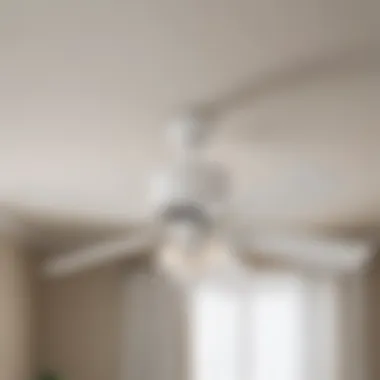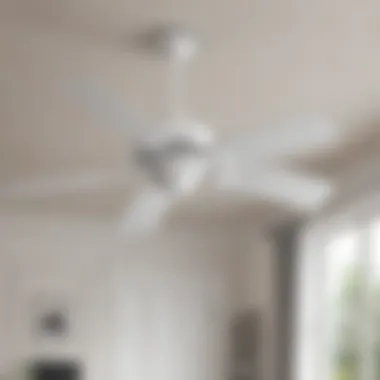Affordable White Ceiling Fans: A Complete Guide


Intro
Choosing the right ceiling fan for your home can be a daunting task, especially when you want to balance aesthetics, functionality, and cost. Affordable white ceiling fans serve as a versatile solution, merging style with practicality. While some might see them as mere appliances designed to circulate air, they can actually contribute significantly to the overall atmosphere of a room. This guide will take you through the journey of selecting the perfect fan, diving into the myriad options available and offering practical insights into maintenance and decor harmony.
Furniture Design Styles
Overview of Popular Styles
To truly appreciate the role of white ceiling fans in home decor, it’s essential to look at how they align with popular design styles. White ceiling fans can seamlessly integrate into various aesthetics—from the sleek lines of modern design to the rustic charm of farmhouse decor. Here are popular styles and how white fans fit in:
- Modern Minimalism: In spaces characterized by clean lines and simple geometric shapes, white ceiling fans with a sleek design can enhance the uncluttered feel.
- Scandinavian Style: Emphasizing functionality and simplicity, these interiors often utilize light colors. A white ceiling fan can add an airy feel that’s perfect for this nature-inspired design.
- Traditional Decor: For classic homes, a white fan with ornate designs can provide a charming touch while complementing vintage furnishings.
- Industrial Chic: Pairing a white fan with exposed brick and metal accents can soften the raw look without competing for attention.
How to Mix and Match Styles
Mixing styles can elevate the uniqueness of your space, making it both personalized and fascinating. Here are some tips:
- Color Coordination: Use shades of white and light hues to connect different elements. A white ceiling fan can bridge the gap between varied styles in the room.
- Textural Balance: Balance out materials. If you have wooden furniture, a white fan can act as a light contrast, setting a refreshing tone.
- Scale Awareness: Consider the size of your furniture when selecting a ceiling fan. A larger fan can complement oversized furnishings, while a smaller fan can suit more compact spaces.
Practical Tips for Homeowners
Essential Buying Tips
When it comes to selecting an affordable white ceiling fan, here are crucial factors to keep in mind:
- Blade Size: Larger rooms require fans with wider blade spans. Conversely, smaller rooms can benefit from compact designs.
- Motor Efficiency: Look for fans with energy-efficient motors to save on electricity bills while maintaining good airflow.
- Style Versatility: Select a fan that suits various settings; you might want to reposition it as your design preferences evolve.
- Installation Options: Check whether the fan comes with a standard mount or a remote option, particularly if your ceiling is high.
Maintenance and Care Guidelines
Maintaining your ceiling fan isn’t just about aesthetics; it's crucial for longevity and functionality:
- Regular Dusting: Accumulated dust can affect performance. While it may seem mundane, regular cleaning keeps your fan operating smoothly.
- Check Blades for Damage: Ensure blades are intact and operate properly. A wobbly fan can lead to unnecessary wear on the motor over time.
- Keep the Motor Lubricated: Following manufacturer guidelines about lubrication can prevent rust and other issues.
"A well-maintained ceiling fan isn't just functional—it becomes an integral part of the living space, echoing your design choices."
In summary, affordable white ceiling fans can add depth and character to your home, all the while providing vital functionality. As you weigh your options within this range, consider how style and maintenance play a role in your ultimate choice.
Preface to Ceiling Fans
Ceiling fans may often be overlooked as mere appliances in a room, but they hold a much more significant role in enhancing comfort and ambiance. This article dives into the world of affordable white ceiling fans, exploring their many advantages and the considerations that accompany their selection. Choosing the right ceiling fan involves understanding its impact on both function and style. In this guide, we aim to unfold the multiple layers that define ceiling fans, particularly focusing on how white ceiling fans can offer a stylish yet practical solution for any home.
The Practical Benefits of Ceiling Fans
Ceiling fans serve as a silent but effective ally in achieving optimal indoor climate. One of their core benefits lies in their ability to circulate air, helping to keep a space feeling cooler in the summer heat and distributing warmth during the colder months. With the right fan, a room can feel several degrees cooler just through airflow, which can lessen reliance on air conditioning and save on utility bills. They are relatively easy to install and maintain, which adds to their appeal.
In addition to comfort, ceiling fans can also extend the lifespan of your HVAC system. They assist heating and cooling devices by promoting efficient air circulation, thereby reducing the workload on these systems. Furthermore, many modern ceiling fans come equipped with energy-efficient motors and blades that optimize performance while minimizing energy consumption. This means that even when the fan is running continuously, it uses up less power compared to older models, providing both environmental and financial benefits.
Why Choose a White Ceiling Fan?
When it comes to color choices for ceiling fans, white stands out for its versatility. A white ceiling fan can harmonize effortlessly with diverse color palettes and design schemes. Whether it’s a cozy country-style home or a sleek modern apartment, a white fan blends in smoothly with the surrounding décor while maintaining a clean, fresh aesthetic.
Moreover, a white finish can help in creating an illusion of more space. In rooms with lower ceilings, a light-colored fan will not seem overwhelming, instead promoting an airy feel in the environment. It is especially crucial in smaller rooms where darker options might cause an enclosed sensation.
Finally, the choice of a white ceiling fan often reflects practicality and cleanliness. Dust and minor wear and tear aren't immediately visible on white surfaces compared to darker shades. For those who enjoy keeping their spaces tidy without the constant worry of visible dirt, white is a strong contender. Thus, with a white ceiling fan, you’re not just selecting a cooling option; you’re also infusing a touch of simplicity and elegance into your home design.
Understanding Different Types of Ceiling Fans
When it comes to enhancing the comfort and aesthetics of your home, understanding the various types of ceiling fans can certainly make a world of difference. The right fan not only improves air circulation but can also serve as a focal point in a room’s decor. Finding the right fit goes beyond just color and style – it’s about functionality as well. By knowing the differences among types of ceiling fans, you’re better equipped to make a choice that suits both your space and lifestyle.
Standard Ceiling Fans
Standard ceiling fans are the most common type found in households today. This kind of fan usually hangs around eight to nine feet above the floor, which allows for optimal airflow. They come in diverse styles, from traditional to modern, making them suitable for almost any room. When thinking about a standard ceiling fan, consider the size of your room. Ideally, the blade span should measure about the same as the width of the room for best airflow.
One key benefit of standard ceiling fans is their versatility. They can be used in nearly every space, ensuring that circulation reaches every corner. Depending on the motor's quality, they can be quite energy-efficient as well.
"A ceiling fan can circulate air effectively, creating a pleasant breeze for warm summer days while being affordable and easy to install."


Low-Profile Ceiling Fans
For people with low ceilings, low-profile ceiling fans could be the answer to your prayers. Otherwise known as hugger fans, these are mounted close to the ceiling, which eliminates the danger of bumping your head while walking beneath them. Despite their compact design, low-profile fans are available in a variety of styles and finishes, including sleek white designs that blend seamlessly into the ceiling.
These fans are not just about saving space; they also provide a good airflow just like their standard counterparts. It is essnetail to select a quality motor to ensure that the fan operates quietly and effectively. Low-profile ceiling fans can work wonderfully in bedrooms, living rooms, or even kitchens, providing an efficient cooling option without detracting from the overall decor.
Energy-Efficient Ceiling Fans
With rising energy costs, more homeowners are turning to energy-efficient ceiling fans as a means to manage their utility bills. These fans are engineered to use significantly less electricity than traditional fans. But what makes them stand out? They often carry the Energy Star label, which ensures that the product meets strict energy efficiency guidelines.
Another interesting feature of energy-efficient ceiling fans is their ability to perform well, even at lower speeds. This means you can run them longer without worrying too much about the electric bill, which can be a game changer during those hot summer months. If you're eco-conscious or simply want to save a few bucks, investing in an energy-efficient ceiling fan can be a smart move.
In summary, having a solid understanding of the different types of ceiling fans available can certainly help you choose the one that fits your unique needs. Whether you opt for standard, low-profile, or energy-efficient options, ensuring the right fit will lead to a more comfortable and aesthetically pleasant living environment.
Key Features of Affordable White Ceiling Fans
When considering affordable white ceiling fans, it's essential to look beyond just the price tag. The key features play a significant role in how effectively a fan operates and integrates into your home. Understanding these features empowers buyers to select a ceiling fan that not only meets aesthetic preferences but is also functional and efficient.
Blade Material and Design
The blades of a ceiling fan might seem trivial, but their material and design are pivotal. They directly influence several factors such as airflow, durability, and the overall visual appeal. Common blade materials include wood, metal, and plastic.
- Wooden Blades: Often offer a classic look. They can be heavy, which might reduce the fan's speed but provide excellent aesthetics.
- Metal Blades: Typically more durable and can often maintain higher speeds. However, they can be a bit noisy at top speeds, which may not be ideal for all buyers.
- Plastic Blades: Generally lightweight and affordable. Their flexibility in designs can cater to various tastes but may lack the durability of wooden or metal blades.
The design of the blades, such as their pitch and shape, can dramatically affect how well a ceiling fan circulates air. For instance, fans with steeper blade pitches can move more air, making them more effective in larger rooms. Furthermore, when selecting a fan, consider the color and style of the blades; white blades complement many decors, providing a consistent and seamless appearance.
Motor Quality and Performance
The heart of the ceiling fan is its motor. A quality motor ensures longevity and performance, often translating to better airflow and quieter operation. It's important to assess the fan's motor details before making a purchase:
- DC Motors: These motors are typically more expensive but offer greater energy efficiency and quieter operation compared to traditional motors.
- AC Motors: More common in budget models, they can still perform well but may consume more energy and generate more noise.
When evaluating motor performance, look for features like multiple speed settings, which allow for flexible control over airflow according to the season. It’s also worth paying attention to the warranty period for the motor, as longer warranties can indicate higher quality and manufacturer confidence in their product.
Control Options: Pull Chains vs. Remote Controls
Another feature to consider is how you operate the ceiling fan. Ceiling fans can come with different types of control mechanisms:
- Pull Chains: A classic, straightforward option. They can be simple to use and handy for fans located in spaces where remotes are impractical. However, this method can be cumbersome if you frequently change settings.
- Remote Controls: Offering ease of use, remotes can enable you to adjust settings from a distance. Some come equipped with additional features like light dimming, making them more versatile.
There are also wall-mounted controls that bridge the gap between these two options, combining the simplicity of pull chains with the convenience of remotes. Ultimately, the choice boils down to user preference; what works for one person may not work for another. Consider your lifestyle and comfort when selecting the control type.
Choosing a ceiling fan with features that meet your specific needs will enhance both functionality and enjoyment in your living space.
Cost Considerations for Ceiling Fans
When it comes to selecting ceiling fans, understanding the costs involved is just as crucial as knowing their design and functionality. Investing in an affordable white ceiling fan doesn't only mean checking out price tags; it's about weighing the right options that suit your budget without sacrificing quality. The decisions you make here can significantly impact your allowance for other home improvements or renovations. Here’s how to break it all down.
Price Ranges for Ceiling Fans
Ceiling fans come in various price brackets depending on their features, brand, and materials. Here's a closer look:
- Budget Range (Under $100): These fans typically offer basic functionality and can be found at major retailers or online marketplaces. They’re ideal for those looking to make quick improvements without a hefty price tag.
Example: A simple white ceiling fan with minimal design elements. - Mid-Range ($100 - $300): In this category, you’ll find more stylish designs and better materials. These fans often incorporate energy-efficient motors and offer varying control options. Example: Energy Star rated fans that contribute positively to your electricity bill.
- Premium Range (Above $300): Premium fans can be quite extravagant, featuring advanced technologies like smart home integration and customizable lighting options. Though expensive, these fans are worth the investment for those planning to keep their fans for many years. Example: A high-end designer ceiling fan with unique artistic blades.
Understanding where your ideal fan might fall within these categories allows you to tailor your search to fit your budget. It’s essential to weigh the upfront cost against the fan’s energy efficiency and durability to save money in the long run.
Factors Influencing Cost
Several factors come into play when determining the cost of a ceiling fan:
- Materials Used: The materials for fans can range from plastic to metal and wood. Typically, fans made of metal tend to be more durable and, therefore, more expensive.
- Motor Quality: Fans featuring high-quality motors typically lead to increased efficiency, thus impacting operational costs positively over time. Brands known for their robust motor design usually carry a higher price tag.
- Brand Reputation: Established brands often command a higher price due to perceived reliability and warranties. However, emerging brands can offer competitive pricing without losing quality.
- Additional Features: Some fans come with integrated lighting, remote controls, or smart home capabilities. These add-ons can easily escalate costs, but they often enhance convenience and energy efficiency.
- Installation Complexity: If a fan requires professional installation, this adds to the overall cost. Fans that are easier to install can reduce extra expenses.
By taking these factors into account, buyers can make informed decisions that align with their financial plans.
"An informed buyer not only saves money but also ensures that the fan selected enhances their living space without breaking the bank."


Understanding costs can mean the difference between settling for a basic model and investing in one that brings both beauty and utility to your home. Assessing your needs, considering essential features, and being mindful of longevity will ultimately lead to a satisfying purchase.
Installation and Maintenance
When it comes to ceiling fans, the importance of installation and maintenance cannot be stressed enough. Both aspects not only impact the performance of the fan but also how well it complements your home’s overall functionality and decor. Proper installation ensures that the fan operates efficiently, while regular maintenance can extend its lifespan. In this guide, we’ll delve into the nuances of these two crucial elements, helping you make sound decisions that can improve your living environment.
Installation Process: DIY vs. Professional Help
Choosing whether to install your ceiling fan yourself or hire a professional is a significant decision.
DIY Installation
If you are handy and enjoy home improvement projects, installing a ceiling fan might be a satisfying challenge. It allows you to put your skills to the test and can save you some bucks on labor costs. However, there are key considerations:
- Understanding Wiring: Familiarity with electrical wiring and safety precautions is imperative.
- Weight of the Fan: Heavier fans might require additional support; failing to secure them properly can lead to accidents.
- Time Requirement: Even if you’re experienced, remember this can be time-consuming. It can also feel like you’re building a ship in a bottle if the instructions are vague.
- Tools Needed: A few basic tools, like screwdrivers and a ladder, should be on hand. Make sure you’re prepared before you start.
On the flip side, if you find yourself scratching your head over the wiring or unsure about the mounting, it's best to call a professional.
Professional Installation
Hiring an expert might add to your costs, but it also comes with its own set of benefits:
- Safety First: Installed by a skilled electrician, the risk of accidents reduces significantly.
- Confidence in Work: Professionals are trained and can install your fan swiftly and correctly. You can trust that everything will work as it should.
- Warranty Considerations: Some manufacturers require professional installation for warranty validity.
In summary, if you’re not comfortable working with electrical components or if the task seems daunting, don’t hesitate to call in the pros. Your peace of mind is worth it.
Maintenance Tips for Longevity
Once your white ceiling fan is up and running, maintaining it is the key to keeping it functional and visually appealing. Here are some handy tips to help you along the way:
- Dust Regularly: Dust can accumulate quickly. Use a microfiber cloth to wipe down the blades and the motor housing. This not only maintains aesthetics but also improves performance.
- Check Connections: Occasionally, check that all screws are tight and the fan is securely mounted. Over time, vibrations can loosen these connections, leading to operational issues.
- Oil the Motor: If your fan is equipped with a motor that requires oiling, make it a habit to apply a few drops as per the manufacturer’s instructions. This keeps the fan running smoothly and silently.
- Inspect the Blades: Periodic inspection for chips or bends in the blades is crucial. Damaged blades can not only be noisy but inefficient as well.
- Change Seasonal Settings: If your fan has a reverse function, flip the switch based on the season. In the summer, run it counter-clockwise for a cooling effect. During winter, switch to clockwise to circulate warm air.
"The longevity of any appliance lies in its care and maintenance. Taking the time to look after your ceiling fan can save you money and hassle over time."
Aesthetic Integration into Home Decor
Choosing a ceiling fan isn't just about functionality; it's also about how well it integrates with your home decor. Aesthetic integration of white ceiling fans can significantly enhance the overall look and feel of a room. It's essential to consider both form and function here. The right fan can act as a focal point or seamlessly blend into the background, depending on your style preferences. Let’s delve deeper into how ceiling fans can fit into various interior designs and the significance of color coordination.
Complementing Various Interior Styles
When selecting a ceiling fan, you want to think about the existing decor. A white ceiling fan can pair beautifully with a range of interior styles. For instance, in a Scandinavian-inspired space, simplicity reigns supreme. A white fan featuring clean lines will complement the minimalistic approach without overshadowing the furniture or decor.
In more traditional settings, a fan with ornate detailing can bring a touch of elegance, while still maintaining its functional role. On the other end of the spectrum, for modern designs, sleek fans can enhance sharp angles and geometric patterns. Don't overlook bohemian or industrial styles, where adding a white fan can lighten the space, contrasting effectively with darker hues or rustic elements.
Factors to consider when matching a ceiling fan to interior styles:
- Material: Is your space characterized by wood, metal, or textiles? Match the fan's material with the predominant elements.
- Size: A larger room might require a more substantial fan to maintain proportion.
- Shape: The shape of the blades can harmonize with design motifs, whether it's rounded, angular, or something unusual.
"The right ceiling fan does more than circulate air; it defines the atmosphere of a room."
Practical Color Coordination
Color coordination is another critical aspect of aesthetic integration. A white ceiling fan inherently offers versatility. However, simply placing a white fan in a room doesn’t guarantee it’ll look good. You must consider its visual relationship with other colors in your space.
For warmer tones, a white fan provides a refreshing contrast, ensuring the room doesn't feel too heavy or dark. On the other hand, in spaces dominated by cool tones like grays and blues, a white fan can harmonize beautifully, adding a hint of brightness without clashing.
Points to keep in mind for effective color coordination:
- Accent Colors: Identify accent colors within your decor and see if the white fan can complement or contrast effectively. For example, if your cushions are navy blue, a white fan can pop against that backdrop.
- Overall Palette: Ensure your fan aligns well with the primary color palette of the room. If the whole design leans towards earth tones, a white ceiling fan can act as a lighthearted note that balances the warm visuals.
- Lighting Scheme: Consider how the fan interacts with lights in your room. Are there pendant lights, lamps, or natural light sources? A white fan can either reflect or absorb light differently, affecting the ambiance.
Ultimately, a well-chosen ceiling fan can elevate your home's decor, provide comfort, and offer a touch of style. Making deliberate choices about how it fits into your aesthetic vision will ensure that it enhances rather than detracts from your intended design.
Energy Efficiency and Environmental Impact
Understanding the interplay between energy efficiency and environmental impact is crucial when it comes to selecting ceiling fans. In recent years, energy conservation has taken center stage, not just out of necessity, but because it reflects a growing awareness about our ecological footprint. For homeowners and DIY enthusiasts alike, choosing an energy-efficient ceiling fan can serve as a simple yet effective step toward creating a greener home environment.
When considering an affordable white ceiling fan, it’s key to look not only at the aesthetic but also at how this appliance fits into your energy consumption habits. If you think of your ceiling fan as a tool for creating comfort while also being mindful of energy usage, you’re on the right track. Here are some specific elements to ponder:
- Long-term Cost Savings: Investing in an energy-efficient fan often translates to lower utility bills in the long run. The initial cost might seem higher, but by using less electricity, you make up that difference over time.
- Environmental Benefits: The less energy consumed, the lesser the strain on our natural resources. A fan that is energy efficient helps reduce greenhouse emissions, which is particularly relevant in today’s climate-conscious landscape.


By aligning your choice of ceiling fan with both aesthetic preferences and a commitment to sustainability, you’re essentially carving a path that supports your lifestyle while also protecting the planet. Now, let’s expand on two significant aspects of energy efficiency in ceiling fans.
Understanding Energy Star Ratings
Energy Star ratings are widely recognized benchmarks for energy efficiency in various appliances, ceiling fans included. This label, which is usually placed on the fan itself or its packaging, indicates that a product meets specific energy-saving criteria set by the U.S. Environmental Protection Agency (EPA).
Energy Star rated ceiling fans are designed to offer better performance while consuming less energy. For homeowners and decorators, understanding these ratings can direct you toward products that will not just brighten up your space but also be kind to your wallet and the environment. When you look for fans with this rating, consider the following:
- Boosted Efficiency: Energy Star ceiling fans often use 20% to 40% less electricity than traditional models. This efficiency is vital in maintaining overall utility costs.
- Better Performance: They typically provide cooler and more uniform airflow, enhancing comfort without leading to excessive energy consumption.
As you navigate your options, always search for the Energy Star label—it’s a solid indicator of quality and efficiency.
Impact on Utility Bills
For many homeowners, the reality of monthly expenses is a significant driving force when it comes to appliance purchases. Ceiling fans can have a considerable impact on your utility bills, especially in climates where air conditioning is necessary. By utilizing energy-efficient ceiling fans, here’s how your bills can benefit:
- Reduced Air Conditioning Dependence: Ceiling fans can make a space feel cooler, allowing you to raise the thermostat setting on your air conditioner. Even a slight adjustment can lead to noticeable savings on your electricity bill.
- Lower Energy Consumption: Affordable white ceiling fans with energy-efficient ratings consume significantly less energy than their counterparts. This reduction can save dollars over time, and it’s worth noting that every bit counts in the grand scheme of monthly billing.
Brands and Market Trends
Understanding the brands and market trends in affordable white ceiling fans is of paramount importance for consumers seeking value without compromising quality. As the demand for ceiling fans surges, due in part to the rising interest in energy efficiency and home aesthetics, knowing which brands stand out and what trends are emerging can significantly influence purchasing decisions. The relationship between reputable brands and their products often serves as a benchmark for quality and dependability, settings expectations for consumers regarding performance and longevity.
Leading Brands in Affordable Ceiling Fans
When it comes to choosing a ceiling fan, discerning buyers pay close attention to brand reputation and customer satisfaction. Some of the leading brands dominating the affordable ceiling fan market include Hunter Fan Company, Westinghouse Lighting, and Harbor Breeze. These brands not only boast a long history in the industry but also present a variety of models that suit different tastes and budgets.
Hunter Fan Company offers a selection of stylish and functional ceiling fans that often come equipped with modern features. For someone looking for functionality wrapped up in design, Hunter's models are both aesthetically pleasing and reliable.
Westinghouse Lighting is another household name, known for producing durable fans with various blade designs. Their range often strikes a balance between traditional and contemporary styles, making them appealing to a broad audience. Customers appreciate Westinghouse's focus on energy efficiency and affordability, which stacks the odds in their favor.
Harbor Breeze fans regularly receive high marks for affordability and functionality. The brand has a focus on offering versatile products that merge style with performance. Their fans often come with remote controls and reversible motor functionality, making them a practical choice for modern homes.
In addition to these well-established brands, it’s essential to check on customer reviews and ratings as they can provide insight into product longevity and performance post-purchase. High ratings in customer feedback often correlate to better resale value as well, which can be crucial when considering potential upgrades or replacements in the future.
Emerging Trends in Fan Designs
The landscape of ceiling fan design is shifting as homeowners and designers alike lean toward innovative aesthetics and functionality. A key trend in recent years has been the move toward minimalist designs; fans are increasingly being used not just for airflow but also as statement pieces that enhance interior decor.
Another rising trend is the integration of smart technology. Smart ceiling fans that can be controlled via smartphones or voice-activated systems are becoming increasingly popular. This development allows users to customize airflow based on real-time conditions, enhancing both comfort and energy savings.
Ceiling fans with energy-efficient LED lighting included are also on the upswing. They bring dual functionality, serving both as a fan and a light source, which speaks to the growing trend of efficient use of space in modern homes.
Incorporating unique materials like wood and metal blends into fan design is becoming more commonplace. The combination adds warmth and character, appealing to a variety of design aesthetics.
"With rising competition and consumer expectations, brands that prioritize sustainability, design, and technology will likely stand out in this evolving market."
In short, being aware of leading brands and the newest trends allows consumers to make informed decisions when selecting affordable white ceiling fans that not only fit their budget but enhance their living spaces. Engaging with these aspects can lead to a fan purchase that is more than just functional, evolving into a design piece within the home.
Final Thoughts on Choosing the Right Fan
Choosing the right ceiling fan is more than just a style decision; it’s about marrying aesthetic appeal with practical functionality. As this article highlighted, white ceiling fans can seamlessly blend into various decor styles, serving both as an elegant design element and a trustworthy cooling solution. When considering which fan to install, take a moment to reflect on not just the immediate appeal but also the long-term values such as energy efficiency, maintenance ease, and how well it fits your unique space.
Making an Informed Decision
When it comes to selecting a ceiling fan, being informed is key. Start by assessing the size of the room. A larger room might call for a fan with a bigger blade span to ensure that airflow is evenly distributed, while a smaller area might benefit from a compact design. Additionally, consider the purpose of the fan: Are you looking purely for aesthetics, or do you need it for cooling and air circulation?
Here are some factors to keep in mind in your decision-making process:
- Room Size: Measure your space to choose a fan that suits it well.
- Ceiling Height: Standard blades might not suit low ceilings; instead, opt for low-profile options.
- Style Alignment: Ensure the fan complements your home's overall decor.
- Energy Consumption: Look for fans that highlight energy efficiency to keep utility bills in check.
Understanding these elements helps you avoid buyer's remorse later on.
The Importance of Customer Reviews
In today's digital marketplace, the word of fellow consumers can be as solid as gold. Customer reviews offer unapologetic insights into performance, durability, and reliability. These opinions often address factors that product descriptions may gloss over, like real-world noise levels or ease of installation.
- Watch for Repeated Comments: If multiple reviews mention a similar issue, it's probable that it’s a legitimate concern.
- Check Ratings and Feedback on Multiple Platforms: Don’t settle for just one source; consider insights from places like Reddit and Amazon to get a rounded view.
- Use Reviews to Gauge Customer Service: Often you can learn about how a brand supports its customers through the purchasing process and afterwards.
In short, customer reviews should be treated as gold nuggets within the vast mine of consumer experience; they provide invaluable data that can help steer you towards a fan that’s right for your home.
"Taking the time to weigh options and understanding customer experiences will pay off. It’s all about ensuring you make the best choice for your comfort and style."
Selecting the right fan involves a dance of practicality and elegance. Keep your priorities straight, trust the voices of fellow consumers, and make a choice that you won’t second guess down the line.















